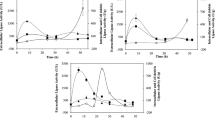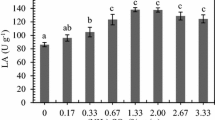Abstract
The use of residues from the industrial processing of palm oil as carbon source and inducer for microbial lipase production can be a way to add value to such residues and to contribute to reduced enzyme costs. The aim of this work was to investigate the feasibility of using palm oil industrial waste as feedstock for lipase production in different cultivation systems. Evaluation was made of lipase production by a selected strain of Aspergillus niger cultivated under solid-state (SSF) and submerged fermentation (SmF). Lipase activity levels up to 15.41 IU/mL were achieved under SSF. The effects of pH and temperature on the lipase activity of the SSF extract were evaluated using statistical design methodology, and maximum activities were obtained between pH 4.0 and 6.5 and at temperatures between 37 and 55 °C. This lipase presented good thermal stability up to 60 °C and higher specificity towards long carbon chain substrates. The results demonstrate the potential application of palm oil industrial residues for lipase production and contribute to the technological advances needed to develop processes for industrial enzymes production.





Similar content being viewed by others
References
Minten, I. J., Abello, N., Schooneveld-Bergmans, M. E. F., & van den Berg, M. A. (2014). Post-production modification of industrial enzymes. Applied Microbiology and Biotechnology, 98, 6215–6231.
Singh, A. K., & Mukhopadhyay, M. (2012). Overview of fungal lipase: a review. Applied Biochemistry and Biotechnology, 166, 486–520.
Hasan, F., Shah, A. A., & Hameed, A. (2006). Industrial applications of microbial lipases. Enzyme and Microbial Technology, 39, 235–251.
Houde, A., Kademi, A., & Leblanc, D. (2004). Lipases and their industrial applications—an overview. Applied Biochemistry and Biotechnology, 118, 155–170.
Gutarra, M. L. E., Godoy, M. G., Maugeri, F., Rodrigues, M. I., Freire, D. M. G., & Castilho, L. R. (2009). Production of an acidic and thermostable lipase of the mesophilic fungus Penicillium simplicissimum by solid-state fermentation. Bioresource Technology, 100, 5249–5254.
Farinas CS: Developments in solid-state fermentation for the production of biomass-degrading enzymes for the bioenergy sector. In Renewable and Sustainable Energy Reviews. pp. 9; 2015:9.
Salgado, J. M., Abrunhosa, L., Venancio, A., Dominguez, J. M., & Belo, I. (2014). Integrated use of residues from olive mill and winery for lipase production by solid state fermentation with Aspergillus sp. Applied Biochemistry and Biotechnology, 172, 1832–1845.
Delabona, P., Pirota, R., Codima, C., Tremacoldi, C., Rodrigues, A., & Farinas, C. (2012). Using Amazon forest fungi and agricultural residues as a strategy to produce cellulolytic enzymes. Biomass and Bioenergy, 37, 243–250.
Tan, C.-H., Ghazali, H. M., Kuntom, A., Tan, C.-P., & Ariffin, A. A. (2009). Extraction and physicochemical properties of low free fatty acid crude palm oil. Food Chemistry, 113, 645–650.
Hansen, S. B., Padfield, R., Syayuti, K., Evers, S., Zakariah, Z., & Mastura, S. (2015). Trends in global palm oil sustainability research. Journal of Cleaner Production, 100, 140–149.
Barros FFC, Simiqueli APR, Andrade CJ, Pastore GM: Production of enzymes from agroindustrial wastes by biosurfactant-producing strains of Bacillus subtilis pp. 9: Biotechnology Research International; 2013:9.
Damaso, M. C. T., Passianoto, M. A., de Freitas, S. C., Freire, D. M. G., Lago, R. C. A., & Couri, S. (2008). Utilization of agroindustrial residues for lipase production by solid-state fermentation. Brazilian Journal of Microbiology, 39, 676–681.
Toscano, L., Gochev, V., Montero, G., & Stoytcheva, M. (2011). Enhanced production of extracellular lipase by novel mutant strain of Aspergillus niger. Biotechnology & Biotechnological Equipment, 25, 2243–2247.
Soares, C. M. F., De Castro, H. F., De Moraes, F. F., & Zanin, G. M. (1999). Characterization and utilization of Candida rugosa lipase immobilized on controlled pore silica. Applied Biochemistry and Biotechnology, 77–79, 745–757.
Falony, G., Armas, J. C., Mendoza, J. C. D., & Hernandez, J. L. M. (2006). Production of extracellular lipase from Aspergillus niger by solid-state fermentation. Food Technology and Biotechnology, 44, 235–240.
Mahadik, N. D., Puntambekar, U. S., Bastawde, K. B., Khire, J. M., & Gokhale, D. V. (2002). Production of acidic lipase by Aspergillus niger in solid state fermentation. Process Biochemistry, 38, 715–721.
Colla LM, Ficanha AMM, Rizzardi J, Bertolin TE, Reinehr CO, Costa JAV: Production and characterization of lipases by two new isolates of Aspergillus through solid-state and submerged fermentation. Biomed Research International 2015:9.
Salihu, A., Alam, M. Z., AbdulKarim, M. I., & Salleh, H. M. (2012). Lipase production: an insight in the utilization of renewable agricultural residues. Resources, Conservation and Recycling, 58, 36–44.
Palma, M. B., Pinto, A. L., Gombert, A. K., Seitz, K. H., Kivatinitz, S. C., Castilho, L. R., & Freire, D. M. G. (2000). Lipase production by Penicillium restrictum using solid waste of industrial babassu oil production as substrate. Applied Biochemistry and Biotechnology, 84–6, 1137–1145.
Di Luccio, M., Capra, F., Ribeiro, N. P., Vargas, G., Freire, D. M. G., & De Oliveira, D. (2004). Effect of temperature, moisture, and carbon supplementation on lipase production by solid-state fermentation of soy cake by Penicillium simplicissimum. Applied Biochemistry and Biotechnology, 113, 173–180.
Raman, J. K., & Gnansounou, E. (2014). Ethanol and lignin production from Brazilian empty fruit bunch biomass. Bioresource Technology, 172, 241–248.
Kamini, N. R., Mala, J. G. S., & Puvanakrishnan, R. (1998). Lipase production from Aspergillus niger by solid-state fermentation using gingelly oil cake. Process Biochemistry, 33, 505–511.
Acknowledgments
The authors thank the Brazilian agencies FAPESP (project no. 2013/20826-0), CAPES, and CNPq for financial support, and the staff of EMBRAPA for technical assistance. We are grateful to F.M. da Cunha for internal review of this paper, and T.F.C. Salum and E.M. Penha for their fruitful collaboration in this research project. The research was also funded by EMBRAPA under grant no. 02.11.07.012.00.00.
Author information
Authors and Affiliations
Corresponding author
Rights and permissions
About this article
Cite this article
Silveira, E.A., Tardioli, P.W. & Farinas, C.S. Valorization of Palm Oil Industrial Waste as Feedstock for Lipase Production. Appl Biochem Biotechnol 179, 558–571 (2016). https://doi.org/10.1007/s12010-016-2013-z
Received:
Accepted:
Published:
Issue Date:
DOI: https://doi.org/10.1007/s12010-016-2013-z




